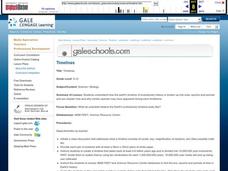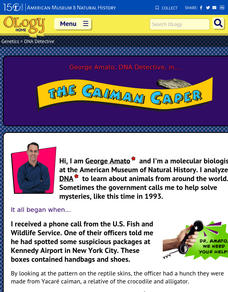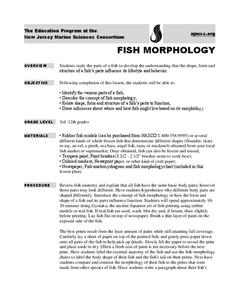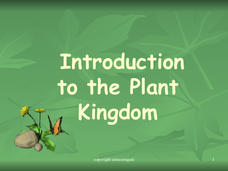Curated OER
Division of Labor
Students study the Industrial Revolution and its effects on workers and productivity in order to explain the concepts of division of labor and cottage industry.
Curated OER
Co-evolution of Plants and Pollinators
Young scholars, while studying the rolls of pollinators and plants, explore co-evolution of mutualistic relationships.
Curated OER
The Ice Age
Students study the differences in the Ice Age terminology and what causes them. In this Ice Age lesson students examine what plants and animals lived during the Ice Age.
Curated OER
Jupiter's Weather Forecast
Students read information about Jupiter and the planet's weather. In this Jupiter weather lesson plan, students read information about Jupiter's weather. Students study a chart about the weather on Earth and Jupiter. Students read a...
Curated OER
ALUMINUM RECYCLING
Students describe how aluminum is recycled. They study a diagram illustrating the recycling path of an aluminum can. They answer questions regarding aluminum. They write letters to recycling firms for information on starting a recycling...
Curated OER
How is Rice Harvested?
Second graders look at how rice is harvested. For this rice harvesting lesson, 2nd graders learn vocabulary associated with rice harvesting. They read or listen to a study guide before making Squishy Rice Balls from balloons and rice.
Curated OER
Who Was Hippocrates?
In this Hippocrates worksheet, learners study and learn facts about the contribution of Hippocrates to medicine. After reading the one page text, students may answer 4 essay questions.
Curated OER
Plant Structure, Function and Growth
Students study three structures of a plant as well as their locations and functions. In this botany lesson students complete several activities on plant organs and their functions.
Curated OER
Climate Change
Students explore environmental care by researching the impact of human beings on our planet. In this climate change lesson plan, students utilize the Internet to read informational text about climate change and the effect it will have on...
Curated OER
Timelines
High schoolers examine evolutionary history; the earth's timeline by creating timelines. They determine the timeframes of era, epochs, and periods and study the species that were evident in each.
Curated OER
Why Do People Fall in Love?
Students discuss human behavior, sexual selection and the underlying genetic and evolutionary reasons for mate selection. The, in groups, they rate the attractiveness of certain individuals and measure facial features for symmetry.
Curated OER
Biological Diversity and Conservation
In this biological diversity worksheets, students will use a word bank to fill in the blank of 8 statements about biological diversity. Then students will decided if 7 statements about the importance of biodiversity are true or false....
Curated OER
The Human Organism
In this digestion and nutrition lesson, 3rd graders test foods to find their vitamin content. Students test for starch and fats then compare their findings on charts and oral reports. The lesson concludes with a teacher directed...
Curated OER
Conservation at a Crossroads Lesson 1: What Is Conservation and Why Does It Matter?
Students explore the concept of conservation. In this conservation lesson, students read articles and primary documents about the Conservation Movement in the United States and compare the movement to today's environmental movements....
Curated OER
A Campfire Conversation
Young scholars examine point of view as it relates to public issues. In this point of view lesson, students become familiar with the point of view of John Muir and Theodore Roosevelt about the wilderness. Young scholars debate if...
Curated OER
Before Pangaea, Rodinia
In this Pangaea and Rodinia worksheet, students complete 16 sentences about Wegener's theory of continental drift, the meaning of Pangaea, and why people rejected the theory of continental drift.
American Museum of Natural History
Saving Species
Some scientists dedicate their lives to researching and protecting endangered species. An online lesson teaches about three scientists around the world who do just that. They learn about spiders, mollusks, and reptiles from North...
University of California
Euclidean Geometry
Go back to where it all began! Investigate how axiomatic systems and Euclidean geometry are based on undefined terms, common notions, postulates, and propositions by examining passages from Euclid's Elements. (Social studies teachers...
American Museum of Natural History
DNA Detective
Match up the DNA code. Pupils read the website from the American Museum of Natural History about how DNA can determine whether a skin is from a particular type of reptile. Using the same technique, learners match up products with the...
Messenger Education
Give Me a Boost—How Gravity Assists Aid Space Exploration
The propellant needed for space explorations runs in the thousands, while paying to get the craft into orbit costs millions! In the second installment of three, two activities explore laws of conservation of energy and momentum. Using...
Consortium for Ocean Science Exploration and Engagement (COSEE)
Fish Morphology
Life comes in all different shapes and sizes, and fish are no exception. Here, young scientists create fish prints as they learn how specific characteristics allow different species to survive in their particular habitats.
LABScI
Kinematics: The Gravity Lab
Falling objects can be brutal if you don't protect your noodle! Scholars explore the motion of falling objects through measuring short intervals to determine if the distance traveled varies with time. Building off of this, scholars...
Channel Islands Film
Island Rotation: Lesson Plan 1
How do scientists provide evidence to support the theories they put forth? What clues do they put together to create these theories? After watching West of the West's documentary Island Rotation class members engage in a series of...
Biology Junction
Introduction to the Plant Kingdom
Plants provide humans with food, shelter, and medications. Scholars gain a better appreciation for plants after learning their functions, divisions, and early ancestors. Each sub-topic includes slides highlighting vocabulary and...























